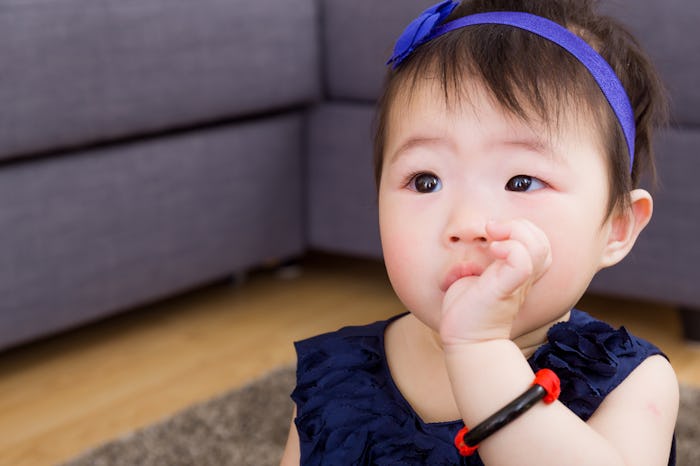Thumb Suckers

How To Safely Treat Thumb Sucking Blisters, According To Experts
Because they can really hurt.
Seeing your little sweetie happily slurping away on their thumb is adorable — at first. But eventually all that cuteness can lead to something a whole lot more painful… blisters. Since you don’t want your child to suffer, you’re going to need to figure out how to safely treat thumb sucking blisters, and hopefully halt the habit in the process.
Babies
For many babies, the rooting for something (anything) to suck on starts right in the womb, according to Dr. Manasa Mantravadi, M.D., a pediatrician and founder of Ahimsa, a collection of stainless steel dinnerware for kids. “Sucking is a normal baby reflex that begins around 29 weeks of gestation,” says Dr. Manatravadi. “Since babies rely on sucking to gain nutrition to survive, perhaps they are practicing for the nutritive sucking they will soon need to do when outside of mom’s belly.”
Eventually, thumb sucking becomes a source of self-soothing, particularly when it’s not linked to mealtime. “Non-nutritive sucking has several benefits like helping infants to self-regulate emotions, a child to relax or focus attention and providing security and comfort,” says Dr. Mantravadi. “Parents may notice it more when their child is bored, tired, upset or anxious.”
Toddlers
For the most part, thumb sucking won’t do any damage to your child’s digits — until they start teething, that is. Blisters can quickly form due to the friction caused by the continuous rubbing from your baby’s lips and tongue, Dr. Bineesh Moyeed, a pharmacist in Chicago tells Romper in an email. “The raised skin on a blister, with the air or liquid underneath it, protects the new forming layers of skin,” says Dr. Moyeed. “Popping it could break that protective barrier, exposing the broken skin to infection.”
If your child is experiencing pain associated with the blisters, there are some things you can do to help, Dr. Anna H. Chacon, M.D., a US board-certified dermatologist, tells Romper in an email. Dr. Chacon recommends giving your kiddo Tylenol. But if your baby has blisters on their fingers, it could lead to something more dangerous. “An impaired skin barrier also predisposes to other skin issues like superficial skin infections, because our mouths contain a lot of microbes,” explains Dr. Chacon. And in addition to potential infections, there could be permanent damage to the skin as well. “If the areas are not treated like with any form of habitual skin disorder, scarring can occur.”
But here’s the rub — literally. Putting a band-aid (or ointment on the area) can make it unsafe for your baby. “For persistent thumb suckers, a band-aid can easily become a choking hazard for younger children,” warns Dr. Moyeed, “and any topical cream may cause harmful side effects if ingested.”
Kids
So if you’re looking for a way for your child to stop sucking their thumb, just know that it’ll probably take some time. “Most children stop non-nutritive sucking between 2 and 4 years of age,” says Dr. Mantravadi. “However, more than 20% of all kids still engage in the habit at age 3.” If your kiddo can’t kick the habit (Dr. Mantravadi suggests starting intervention by age 3), you might need to step in, since prolonged thumb sucking can affect your child’s teeth and how they line up. “The most common effect of a prolonged thumb sucking habit is the upward movement of the central incisors resulting in an anterior open bite,” she says.
Depending on your child’s age, you can try sitting them down and explaining how thumb sucking might affect them. “Having open honest dialogue with your older child that continues to suck can be beneficial,” says Dr. Mantravadi. “Show them in the mirror what is happening to their teeth, educate them on how germs from their hands can go into their mouth and remind them that they are becoming a big kid at their age.” And heaping on the praise definitely doesn’t hurt. “Using positive stickers on a calendar for the days when they don’t do it is also a reward tool,” adds Dr. Chacon. “Identify triggers that encourage thumb sucking and try to avoid them.” Since thumb sucking is sometimes related to stress you can swap in a stuffed anipeels ro mal or a lovey for them to squeeze when your child is upset instead of turning to their thumb for comfort.
Thumb sucking is extremely common in little kids, but as time goes on, it can become a hard habit to break. Staying positive and helping your little one if their thumb gets an owie can all help towards outgrowing this early childhood chapter. Soon, your baby will be blister-free. And that, moms, doesn’t suck.
Experts:
Dr. Manasa Mantravadi, M.D., a pediatrician
Dr. Bineesh Moyeed, a pharmacist in Chicago
Dr. Anna H. Chacon, M.D., a US board-certified dermatologist
This article was originally published on